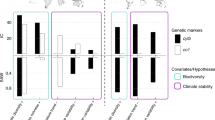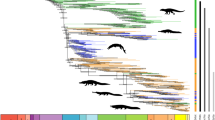Abstract
Understanding the mechanisms by which the abiotic and biotic requirements of species, or ecological niches, change over time is a central issue in evolutionary biology. Niche evolution is poorly understood at both the macroecological and macroevolutionary scales, as niches can shift over short periods of time but appear to change more slowly over longer timescales. Although reconstructing past niches has always been a major concern for palaeontologists and evolutionary biologists, only a few recent studies have successfully determined the factors that affect niche evolution. Here, we compare the evolution of climatic niches in four main groups of terrestrial vertebrates using a modelling approach integrating both palaeontological and neontological data, and large-scale datasets that contain information on the current distributions, phylogenetic relationships and fossil records for a total of 11,465 species. By reconstructing historical shifts in geographical ranges and climatic niches, we show that niche shifts are significantly faster in endotherms (birds and mammals) than in ectotherms (squamates and amphibians). We further demonstrate that the diversity patterns of the four clades are directly affected by the rate of niche evolution, with fewer latitudinal shifts in ectotherms.
This is a preview of subscription content, access via your institution
Access options
Access Nature and 54 other Nature Portfolio journals
Get Nature+, our best-value online-access subscription
$29.99 / 30 days
cancel any time
Subscribe to this journal
Receive 12 digital issues and online access to articles
$119.00 per year
only $9.92 per issue
Buy this article
- Purchase on Springer Link
- Instant access to full article PDF
Prices may be subject to local taxes which are calculated during checkout



Similar content being viewed by others
Change history
13 February 2018
In the version of this Article originally published, in Fig. 3a the first boundary was incorrectly labelled the “K/T boundary”; it should have read the “K/Pg boundary”. The two equations in the main text were incorrectly omitted from the HTML. In the description of the posterior distribution of an ancestral state, the normal distribution was incorrectly described as being “assigned as prior to the node value”; it should have read “assigned as calibration to the node value”. In the associated equation (the second equation in the text), the denominator of the last term was incorrectly given as “Node prior”; it should have read “Node calibration”. In the same equation, the numerator of the third term on the right-hand side of the equation contained incorrect superscript notation on the x and this is shown in the full equation in the notice below.
References
Pearman, P. B., Guisan, A., Broennimann, O. & Randin, C. F. Niche dynamics in space and time. Trends Ecol. Evol. 23, 149–158 (2008).
Wiens, J. J. & Graham, C. H. Niche conservatism: integrating evolution, ecology, and conservation biology. Annu. Rev. Ecol. Evol. Syst. 36, 519–539 (2005).
Crisp, M. D. et al. Phylogenetic biome conservatism on a global scale. Nature 458, 754–756 (2009).
Prinzing, A., Durka, W., Klotz, S. & Brandl, R. The niche of higher plants: evidence for phylogenetic conservatism. Proc. R Soc. Lond. B 268, 2383–2389 (2001).
Svenning, J. C. & Skov, F. Could the tree diversity pattern in Europe be generated by postglacial dispersal limitation? Ecol. Lett. 10, 453–460 (2007).
Wiens, J. J. & Donoghue, M. J. Historical biogeography, ecology and species richness. Trends Ecol. Evol. 19, 639–644 (2004).
Quintero, I. & Wiens, J. J. Rates of projected climate change dramatically exceed past rates of climatic niche evolution among vertebrate species. Ecol. Lett. 16, 1095–1103 (2013).
Chaboureau, A. C., Sepulchre, P., Donnadieu, Y. & Franc, A. Tectonic-driven climate change and the diversification of angiosperms. Proc. Natl. Acad. Sci. USA 111, 14066–14070 (2014).
Kostikova, A., Litsios, G., Salamin, N. & Pearman, P. B. Linking life-history traits, ecology, and niche breadth evolution in North American eriogonoids (Polygonaceae). Am. Nat. 182, 760–774 (2013).
Jezkova, T. & Wiens, J. J. Rates of change in climatic niches in plant and animal populations are much slower than projected climate change. Proc. R. Soc. B 283, 20162104 (2016).
Kozak, K. & Wiens, J. Accelerated rates of climatic-niche evolution underlie rapid species diversification. Ecol. Lett. 13, 1378–1389 (2010).
Araújo, M. B. et al. Heat freezes niche evolution. Ecol. Lett. 16, 1206–12119 (2013).
Dillon, M. E., Wang, G. & Huey, R. B. Global metabolic impacts of recent climate warming. Nature 467, 704–706 (2010).
Deutsch, C. A. et al. Impacts of climate warming on terrestrial ectotherms across latitude. Proc. Natl. Acad. Sci. USA 105, 6668–6672 (2008).
Farmer, C. G. Parental care: the key to understanding endothermy and other convergent features in birds and mammals. Am. Nat. 155, 326–334 (2000).
Angiletta, M. J. Thermal Adaptation: A Theoretical and Empirical Analysis. (Oxford Univ. Press,New York, 2009).
Crompton, A. W., Taylor, C. R. & Jagger, J. A. Evolution of homeothermy in mammals. Nature 272, 333–336 (1978).
Rolland, J. & Salamin, N. Niche width impacts vertebrate diversification. Glob. Ecol. Biogeogr. 25, 1252–1263 (2016).
Zachos, J. C., Dickens, G. R. & Zeebe, R. E. An early Cenozoic perspective on greenhouse warming and carbon-cycle dynamics. Nature 451, 279–283 (2008).
Cramer, B. S., Toggweiler, J. R., Wright, M. E., Katz, M. E. & Miller, K. G. Ocean overturning since the Late Cretaceous: inferences from a new benthic foraminiferal isotope compilation. Paleoceanography 24, PA4216 (2009).
Prokoph, A., Shields, G. A. & Veizer, J. Compilation and time-series analysis of a marine carbonate δ18O, δ13C, 87Sr/86Sr and δ34S database through Earth history. Earth Sci. Rev. 87, 113–133 (2008).
Bolnick, D. I. et al. Why intraspecific trait variation matters in community ecology. Trends Ecol. Evol. 26, 183–192 (2011).
Violle, C. et al. The return of the variance: intraspecific variability in community ecology. Trends Ecol. Evol. 27, 244–252 (2012).
Hart, S. P., Schreiber, S. J. & Levine, J. M. How variation between individuals affects species coexistence. Ecol. Lett. 19, 825–838 (2016).
Stevens, V. M. et al. A comparative analysis of dispersal syndromes in terrestrial and semi-terrestrial animals. Ecol. Lett. 17, 1039–1052 (2014).
Dynesius, M. & Jansson, R. Evolutionary consequences of changes in species’ geographical distributions driven by Milankovitch climate oscillations. Proc. Natl. Acad. Sci. USA 97, 9115–9120 (2000).
Ge, D. et al. Evolutionary history of lagomorphs in response to global environmental change. PLoS. ONE 8, e59668 (2013).
Rolland, J., Condamine, F. L., Beeravolu, C. R., Jiguet, F. & Morlon, H. Dispersal is a major driver of the latitudinal diversity gradient of Carnivora. Glob. Ecol. Biogeogr. 24, 1059–1071 (2015).
Buckley, L. B., Hurlbert, A. H. & Jetz, W. Broad-scale ecological implications of ectothermy and endothermy in changing environments. Glob. Ecol. Biogeogr. 21, 873–885 (2012).
Fenton, I. S. et al. The impact of Cenozoic cooling on assemblage diversity in planktonic foraminifera. Phil. Trans. R. Soc. B 371, 20150224 (2016).
Duchêne, D. A. & Cardillo, M. Phylogenetic patterns in the geographic distributions of birds support the tropical conservatism hypothesis. Glob. Ecol. Biogeogr. 24, 1261–1268 (2015).
Pyron, R. A. & Wiens, J. J. Large-scale phylogenetic analyses reveal the causes of high tropical amphibian diversity. Proc. R Soc. B 280, 20131622 (2013).
Pyron, R. A. Temperate extinction in squamate reptiles and the roots of latitudinal diversity gradients. Glob. Ecol. Biogeogr. 23, 1126–1134 (2014).
Wake, D. B. & Vredenburg, V. T. Colloquium paper: are we in the midst of the sixth mass extinction? A view from the world of amphibians. Proc. Natl. Acad. Sci. USA 105, 11466–11473 (2008).
Guisan, A. & Thuiller, W. Predicting species distribution: offering more than simple habitat models. Ecol. Lett. 8, 993–1009 (2005).
Bininda-Emonds, O. R. et al. The delayed rise of present-day mammals. Nature 446, 507–512 (2007).
Fritz, S. A., Bininda-Emonds, O. R. & Purvis, A. Geographical variation in predictors of mammalian extinction risk: big is bad, but only in the tropics. Ecol. Lett. 12, 538–549 (2009).
Kuhn, T. S., Mooers, A. Ø. & Thomas, G. H. A simple polytomy resolver for dated phylogenies. Methods Ecol. Evol. 2, 427–436 (2011).
Jetz, W., Thomas, G. H., Joy, J. B., Hartmann, K. & Mooers, A. O. The global diversity of birds in space and time. Nature 491, 444–448 (2012).
Pyron, R. A. & Wiens, J. J. A large-scale phylogeny of Amphibia including over 2800 species, and a revised classification of extant frogs, salamanders, and caecilians. Mol. Biol. Evol. 61, 543–583 (2011).
Pyron, R. A. & Burbrink, F. T. Early origin of viviparity and multiple reversions to oviparity in squamate reptiles. Ecol. Lett. 17, 13–21 (2014).
Drummond, A. J., Suchard, M. A., Xie, D. & Rambaut, A. Bayesian phylogenetics with BEAUti and the BEAST 1.7. Mol. Biol. Evol. 29, 1969–1973 (2012).
Hijmans, R. J., Cameron, S. E., Parra, J. L., Jones, P. G. & Jarvis, A. Very high resolution interpolated climate surfaces for global land areas. Int. J. Climatol. 25, 1965–1978 (2005).
Wright, N., ahirovic, S., Müller, R. D. & Seton, M. Towards community-driven paleogeographic reconstructions: integrating open-access paleogeographic and paleobiology data with plate tectonics. Biogeosciences 10, 1529–1541 (2013).
Slater, G. J., Harmon, L. J. & Alfaro, M. E. Integrating fossils with molecular phylogenies improves inference of trait evolution. Evolution 66, 3931–3944 (2012).
Metropolis, N., Rosenbluth, A. W., Rosenbluth, M. N., Teller, A. W. & Teller, E. Equation of state calculations by fast computing machines. J. Chem. Phys. 21, 1087–1092 (1953).
Hastings, W. K. Monte Carlo sampling methods using Markov chains and their applications. Biometrika 57, 97–109 (1970).
Gelman, A., CarlinJ. B., Stern, J. B. & Rubin, D. B. Bayesian Data Analysis 2. (Chapman & Hall/CRC, London, 2014).
Rambaut, A., Suchard, M. A., Xie, D. & Drummond, A. J. Tracer v.1.6 http://tree.bio.ed.ac.uk/software/tracer/ (2014).
Pulliam, H. R. On the relationship between niche and distribution. Ecol. Lett. 3, 349–361 (2000).
Araújo, M. B. et al. Heat freezes niche evolution. Ecol. Lett. 16, 1206–1219 (2013).
Acknowledgements
The authors thank the Vital-IT facilities of the Swiss Institute of Bioinformatics for the computational support. J.R. received a Banting postdoctoral fellowship at university of British Columbia. D. Silvestro received funding from the Swedish Research Council (2015-04748) and from the Knut and Alice Wallenberg foundation. This work was funded by the University of Lausanne and the Swiss National Science Foundation (CRSIII3-147630) to N.S.
Author information
Authors and Affiliations
Contributions
J.R., D.S. and N.S. designed the study and the methodology. J.R. wrote the first version of the manuscript and all co-authors contributed to the writing or commented the final version of the manuscript.
Corresponding author
Ethics declarations
Competing interests
The authors declare no competing financial interests.
Additional information
Publisher’s note: Springer Nature remains neutral with regard to jurisdictional claims in published maps and institutional affiliations.
A correction to this article is available online at https://doi.org/10.1038/s41559-018-0492-8.
Supplementary information
Supplementary Information
Supplementary Methods and Results, Supplementary References, Supplementary Figures 1–11, Supplementary Tables 1–4.
Rights and permissions
About this article
Cite this article
Rolland, J., Silvestro, D., Schluter, D. et al. The impact of endothermy on the climatic niche evolution and the distribution of vertebrate diversity. Nat Ecol Evol 2, 459–464 (2018). https://doi.org/10.1038/s41559-017-0451-9
Received:
Accepted:
Published:
Issue Date:
DOI: https://doi.org/10.1038/s41559-017-0451-9
This article is cited by
-
Global latitudinal gradients and the evolution of body size in dinosaurs and mammals
Nature Communications (2024)
-
Climate change from an ectotherm perspective: evolutionary consequences and demographic change in amphibian and reptilian populations
Biodiversity and Conservation (2024)
-
Molecular phylogeny of mega-diverse Carabus attests late Miocene evolution of alpine environments in the Himalayan–Tibetan Orogen
Scientific Reports (2023)
-
Interannual climate variability improves niche estimates for ectothermic but not endothermic species
Scientific Reports (2023)
-
Conceptual and empirical bridges between micro- and macroevolution
Nature Ecology & Evolution (2023)



